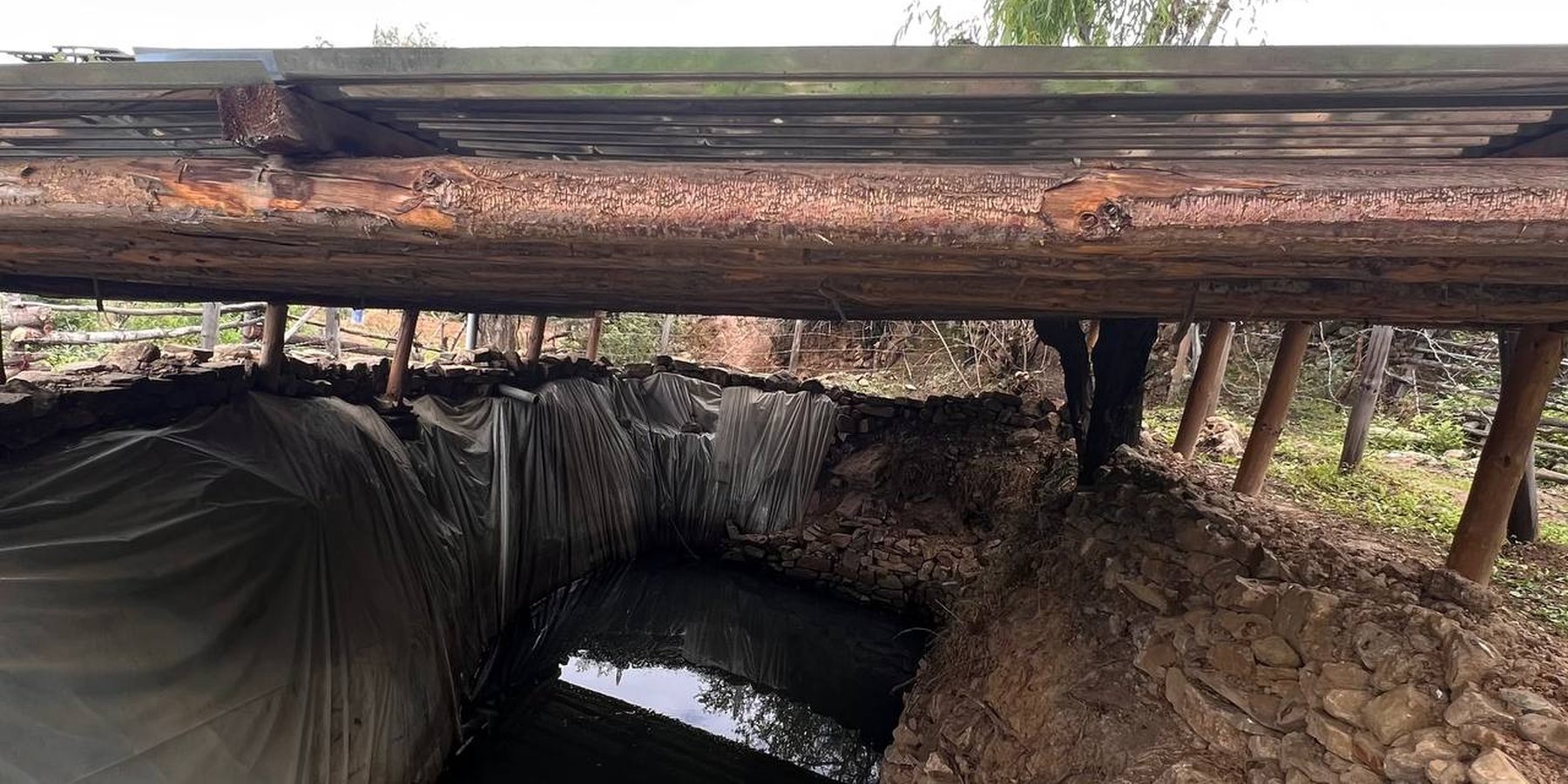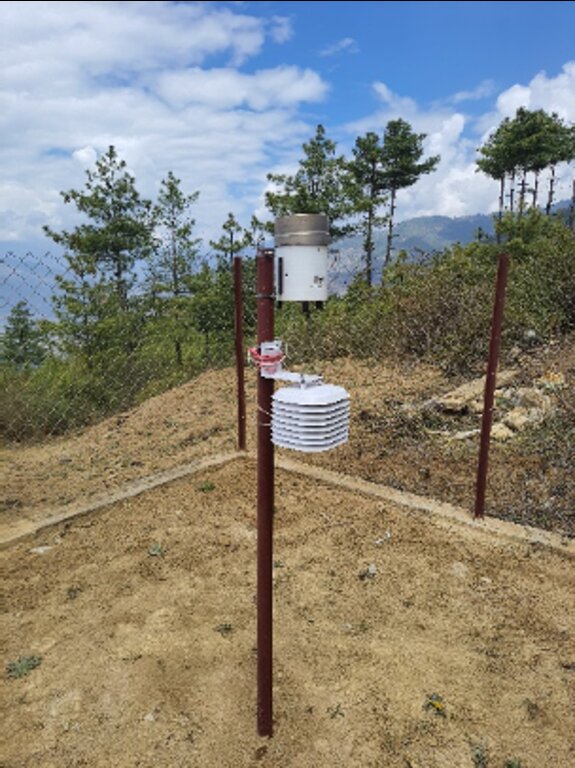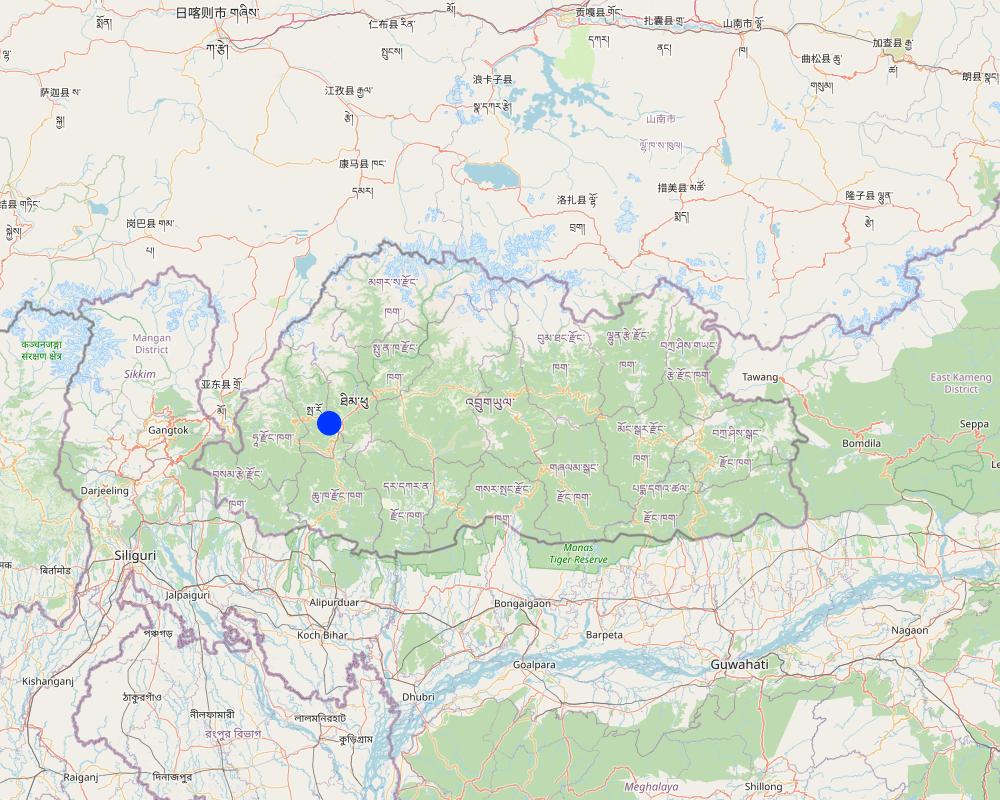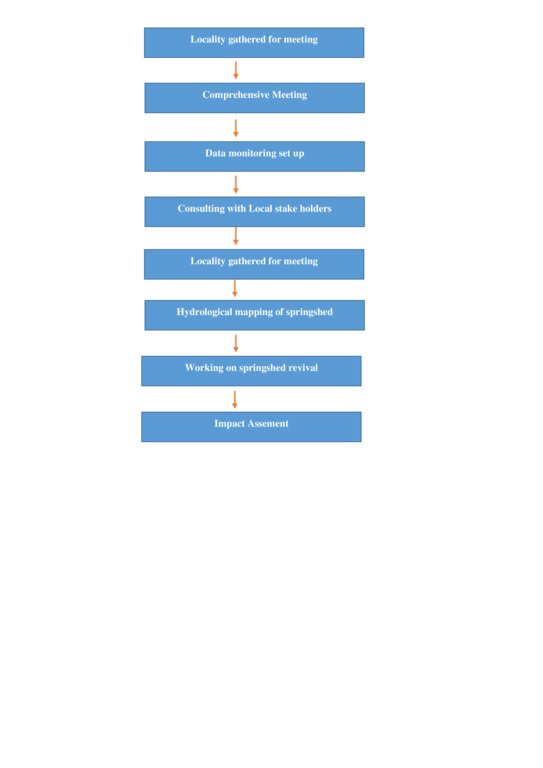Nature-based Solutions for Springshed Revival [ภูฏาน]
- ผู้สร้างสรรค์:
- การอัพเดท:
- ผู้รวบรวม: Karma Wangdi
- ผู้เรียบเรียง: Haka Drukpa
- ผู้ตรวจสอบ: Rima Mekdaschi Studer, William Critchley
Rangzhin Thablam Thok Chhuka Sakhong Nyamsuung (རང་བཞིན་ཐབས་ལམ་ཐོག་ཆུ་རྐ་ས་ཁོངས་ཉམས་སྲུང་།)
approaches_6850 - ภูฏาน
ดูส่วนย่อย
ขยายทั้งหมด ย่อทั้งหมด1. ข้อมูลทั่วไป
1.2 รายละเอียดที่ติดต่อได้ของผู้รวบรวมและองค์กรที่เกี่ยวข้องในการประเมินและการจัดเตรียมทำเอกสารของแนวทาง
วิทยากรหลัก
ผู้ใช้ที่ดิน:
Dorji Gem
n/a
Lholing, Shaba Gewog (Block), Paro Dzongkhag (District)
ภูฏาน
ผู้ใช้ที่ดิน:
Chencho Chencho
n/a
Lholing, Shaba Gewog (Block), Paro Dzongkhag (District)
ภูฏาน
ผู้ใช้ที่ดิน:
Dorji Chencho
n/a
Lholing, Shaba Gewog (Block), Paro Dzongkhag (District)
ภูฏาน
ผู้ใช้ที่ดิน:
Nidup Wangmo
n/a
Lholing, Shaba Gewog (Block), Paro Dzongkhag (District)
ภูฏาน
ชื่อของโครงการซึ่งอำนวยความสะดวกในการทำเอกสารหรือการประเมินแนวทาง (ถ้าเกี่ยวข้อง)
Strengthening national-level institutional and professional capacities of country Parties towards enhanced UNCCD monitoring and reporting – GEF 7 EA Umbrella II (GEF 7 UNCCD Enabling Activities_Umbrella II)ชื่อของโครงการซึ่งอำนวยความสะดวกในการทำเอกสารหรือการประเมินแนวทาง (ถ้าเกี่ยวข้อง)
National Soil Services Center, Department of Agric (National Soil Services Center, Department of Agric) - ภูฏาน1.3 เงื่อนไขที่เกี่ยวข้องกับการใช้ข้อมูลที่ได้บันทึกไว้ผ่านทาง WOCAT
วันที่เก็บรวบรวมข้อมูล (ภาคสนาม):
12/07/2023
ผู้รวบรวมและวิทยากรหลักยอมรับเงื่อนไขเกี่ยวกับการใช้ข้อมูลที่ถูกบันทึกผ่านทาง WOCAT:
ใช่
2. คำอธิบายของแนวทาง SLM
2.1 การอธิบายแบบสั้น ๆ ของแนวทาง
Springshed revival can be achieved through Nature-based Solutions (NbS) with a hydrogeological approach, complemented by socio-ecological inputs, and engineering surveys.
2.2 การอธิบายอย่างละเอียดของแนวทาง
การอธิบายอย่างละเอียดของแนวทาง:
Springs are natural occurrences where fresh water emerges from the ground through openings known as spring vents. They are outlets from aquifers, water-bearing layers underground, to the surface. The water in springs originates from rainfall during specific seasons, which falls on the springshed, infiltrates the ground and is collected as groundwater. When the groundwater is pressurized and rises, it creates springs, which then contribute to the flow of water into rivers or other water bodies. In mountainous regions like Bhutan, springs serve as the primary water source for rural households (ICIMOD, 2021).
Spring revival through “nature-based solutions” (NbS) in springsheds refers to a comprehensive effort aimed at reviving and restoring the functionality of springs. The primary objectives of spring revival initiatives include ensuring sustainable water supply, mitigating the threat of springs drying, conserving biodiversity, and improving the livelihoods of communities dependent on spring water. To achieve these goals, diverse methods are employed, involving various stakeholders. While spring revival offers numerous advantages, it also presents certain disadvantages that should be considered (Konek & Samanta, 2022).
The methods used under NbS to revive springs are multifaceted and typically involve a combination of hydrogeological, ecological, hydrological, and community-based approaches. Hydrogeology can lead to a better understanding of aquifers and the nature of springs and springsheds, thus providing ways for better management. Ecological methods focus on restoring the natural catchment area (the springshed itself) and improving vegetation cover to enhance water infiltration and recharge. Measures such as reforestation, contour trenching, and check dams are implemented to reduce erosion, promote groundwater recharge, and maintain spring flow. Hydrological interventions include the construction of recharge structures, groundwater recharge pits, and percolation tanks to replenish the aquifer and ensure sustained spring flow. Community-based approaches encompass raising awareness, capacity building, and participation in springshed conservation and management activities. These efforts often include the establishment of user groups, water committees, and the adoption of sustainable water use practices (Shrestha et al., 2017).
Stakeholders play vital roles in spring revival initiatives. Local communities living in Lholing areas are key stakeholders as they are directly affected by water availability and are actively involved in the preservation and management of springs. Government agencies such as the Department of Water, Department of Forests and Park Services and Gewog Administration provide technical expertise, funding, and policy support. Academic institutions and research organizations contribute scientific knowledge, monitoring, and evaluation, while international agencies and donor organizations may provide financial assistance and expertise.
According to Tamba et al. (2012) the advantages of spring revival are significant and far-reaching. By restoring spring flow, communities get access to a reliable and sustainable water source, which is crucial for their domestic, agricultural, and livestock needs. Spring revival through NbS also contributes to biodiversity conservation, as the presence of flowing water supports diverse aquatic and terrestrial ecosystems, including endemic species. Moreover, the revival of springs enhances groundwater recharge, which can benefit other water sources in the area. The community involvement and capacity-building aspects of NbS initiatives foster social cohesion, empowerment, and the development of local governance structures. Revived springs have the potential to enhance community resilience to climate change by providing water during periods of drought or erratic rainfall.
However, NbS also come with certain challenges and disadvantages. Adequate financial resources and long-term funding commitments are often required, which can pose a challenge in resource-constrained settings. Technical expertise and knowledge gaps may hinder the effectiveness of revival methods, emphasizing the need for capacity building and technical support. The involvement of multiple stakeholders can lead to coordination issues and conflicts of interest. Furthermore, the success of spring revival initiatives relies heavily on community participation. Thus, lack of community engagement or ownership can hinder sustainability. Environmental and social impacts need to be carefully considered, as inappropriate interventions or changes in hydrological patterns can have unintended consequences on ecosystems and communities (Khadka et al., 2019).
2.3 รูปภาพของแนวทาง
2.4 วีดีโอของแนวทาง
วันที่:
12/07/2023
2.5 ประเทศ ภูมิภาค หรือสถานที่ตั้งที่ได้นำแนวทางไปใช้
ประเทศ:
ภูฏาน
ภูมิภาค/รัฐ/จังหวัด: :
Shaba, Paro
ข้อมูลเฉพาะเพิ่มเติมของสถานที่ตั้ง:
Lholing Chiwog, Shaba Geog, Paro Dzongkhag
Map
×2.6 วันที่เริ่มต้นและสิ้นสุดของแนวทาง
ระบุปีที่เริ่ม:
2018
ถ้าไม่รู้ปีที่แน่นอนให้ประมาณวันที่ที่ริเริ่มใช้แนวทางนี้ :
น้อยกว่า 10 ปี (เร็วๆนี้)
2.7 ประเภทของแนวทาง
- ใช้โครงงานหรือแผนงานเป็นฐาน
2.8 เป้าหมายหรือวัตถุประสงค์หลักของแนวทาง
Nature-based solution to reviving springs as a source of water for:
1. Drinking
2. For animal use
3. Agriculture
2.9 เงื่อนไขที่เอื้ออำนวยหรือเป็นอุปสรรคต่อการนำเทคโนโลยีภายใต้แนวทางนี้ไปปฏิบัติใช้
บรรทัดฐานและค่านิยมทางสังคม วัฒนธรรม ศาสนา
- เอื้ออำนวย
Water became the source of whole existence.
การมีไว้ให้หรือการเข้าถึงแหล่งการเงินและบริการ
- เอื้ออำนวย
This type of project can be brought into action with the help of continued implementation of activities and grants
การจัดตั้งระดับองค์กร
- เอื้ออำนวย
More stakeholders
การร่วมมือหรือการทำงานประสานกันของผู้ลงมือปฏิบัติ
- เอื้ออำนวย
กรอบแนวทางในการดำเนินการด้านกฎหมาย (การถือครองที่ดิน สิทธิในการใช้ที่ดินและน้ำ)
- เอื้ออำนวย
Water Act of Bhutan 2010
นโยบาย
- เอื้ออำนวย
Drinking water has been a priority over other usage as per our Act and policies.
การกำกับดูแลที่ดิน (การตัดสินใจ การนำเอาไปปฏิบัติใช้ และการบังคับใช้)
- เอื้ออำนวย
The Department of Water and Department of Forests and Park Services have been promoting conservation and management of water resources.
ความรู้เกี่ยวกับ SLM การเข้าถึงการสนับสนุนด้านเทคนิค
- เป็นอุปสรรค
Our farmers usually lacks the knowledge on SLM principle left without assisting in this type of field.
ตลาด (จัดซื้อปัจจัยนำเข้า ขายผลิตภัณฑ์) และราคา
- เอื้ออำนวย
The communities have access to local markets to sell their agricultural products.
ปริมาณงานที่ทำได้ กำลังคนที่มีให้
- เป็นอุปสรรค
Required huge labour contributions. Labour shortage is a problem
อื่นๆ
- เอื้ออำนวย
3. การมีส่วนร่วมและบทบาทของผู้มีส่วนได้ส่วนเสียที่เกี่ยวข้อง
3.1 ผู้มีส่วนได้ส่วนเสียที่เกี่ยวข้องในแนวทางนี้และบทบาท
- ผู้ใช้ที่ดินระดับท้องถิ่นหรือชุมชนระดับท้องถิ่น
A total of 8 stakeholders were involved, only two of them are directly assisting in spring revival
Helped as a labor who have contributed in making trenches and fencing around the shed.
- ผู้เชี่ยวชาญ SLM หรือที่ปรึกษาการเกษตร
8 Foresters from the Divisional Forest Office, Paro were involved
Planning, coordinating and providing technical assistance for the spring revival
- รัฐบาลระดับท้องถิ่น
Gup (Local Chief) and Tshogpa of Shaba Gewog Administration.
Administrative support
- รัฐบาลแห่งชาติ (ผู้วางแผน ผู้ทำการตัดสินใจ)
Department of Forests and Park Services
Provide technical support
- องค์การระหว่างประเทศ
Green Climate Fund, ICIMOD
Provide funding support and tecnnical expertise
3.2 การเกี่ยวข้องของผู้ใช้ที่ดินระดับท้องถิ่นหรือชุมชนระดับท้องถิ่นในช่วงต่างๆของแนวทาง
| ความเกี่ยวข้องของผู้ใช้ที่ดินระดับท้องถิ่นหรือชุมชนระดับท้องถิ่น | ระบุผู้ที่มีส่วนเกี่ยวข้องและอธิบายกิจกรรม | |
|---|---|---|
| การริเริ่มหรือการจูงใจ | ปฏิสัมพันธ์ | A person from each household was involved in the initial planning and meeting with the specialists to agree to. |
| การวางแผน | ไม่ลงมือ | The plannings were mostly done by specialists from the forest department. |
| การดำเนินการ | จ่ายเงินหรือสนับสนุนจากภายนอก | Land users/local community were engaged as paid labours. |
| การติดตามตรวจสอบหรือการประเมินผล | ปฏิสัมพันธ์ | Twice a year monitoring is done by the specialists and other minor monitoring is dine by the community around the springsheds. |
| ไม่มี | No research was carried out. |
3.3 แผนผังแสดงขั้นตอนการทำงาน (ถ้ามี)
คำอธิบาย:
1. Comprehensive mapping of springs and springsheds.
2. Setting up of a data monitoring system.
3. Understanding socio-economic and governance systems of springs.
4. Hydrogeological mapping.
5. Creating a conceptual hydrogeological layout of the springshed.
6. Classification of spring type, identifying mountain aquifer and demarcating recharge area.
7. Developing springshed management and governance protocols and
8. Impact assessment.
ผู้เขียน:
Singye Dorji & Tshering Gyeltshen
3.4 การตัดสินใจเลือกใช้เทคโนโลยี SLM
ระบุผู้ที่ทำการตัดสินใจเลือกเทคโนโลยีมากกว่าหนึ่งวิธีไปปฏิบัติใช้:
- ผู้เชี่ยวชาญ SLM เป็นผู้ตัดสินใจหลัก ที่ติดตามให้คำปรึกษากับผู้ใช้ที่ดิน
4. การสนับสนุนด้านเทคนิค การสร้างขีดความสามารถ และการจัดการด้านความรู้
4.1 การสร้างขีดความสามารถ / การอบรม
ได้มีการจัดอบรมให้แก่ผู้ใช้ที่ดินหรือผู้มีส่วนได้ส่วนเสียคนอื่น ๆ หรือไม่:
ไม่ใช่
4.2 การบริการให้คำแนะนำ
ผู้ใช้ที่ดินมีการเข้าถึงการรับบริการให้คำปรึกษาหรือไม่:
ใช่
ระบุว่ามีบริการให้คำปรึกษาหรือไม่:
- ไปเยี่ยมชมสถานที่
4.3 การเสริมความแข็งแกร่งให้กับสถาบัน (การพัฒนาองค์กร)
สถาบันได้รับการจัดตั้งขึ้นมาหรือเสริมความแข็งแกร่งโดยแนวทางนี้หรือไม่:
- ใช่ เล็กน้อย
ระบุระดับของสถาบันที่ได้รับการเสริมความแข็งแกร่งหรือจัดตั้งขึ้นมา:
- ท้องถิ่น
4.4 การติดตามตรวจสอบและประเมินผล
การติดตามตรวจสอบและประเมินผลเป็นส่วนหนึ่งของแนวทางหรือไม่:
ใช่
ความคิดเห็น:
Physical on site monitoring and evaluating the springshed
ถ้าตอบว่าใช่ แสดงว่าการจัดเตรียมเอกสารนี้มุ่งหวังที่จะเอาไปใช้สำหรับการติดตามตรวจสอบและประเมินผลใช่หรือไม่:
ไม่ใช่
4.5 การวิจัย
การวิจัยเป็นส่วนหนึ่งของแนวทางหรือไม่:
ไม่ใช่
5. การสนับสนุนด้านการเงินและวัสดุอุปกรณ์
5.1 ระบุงบประมาณประจำปีสำหรับแนวทาง SLM นี้
ถ้าหากว่างบประมาณประจำปีไม่เป็นที่ทราบแน่นอน ให้ระบุช่วงลงไป:
- < 2,000
แสดงความคิดเห็น (แหล่งของการระดมทุน ผู้บริจาคคนสำคัญ):
Royal Government of Bhutan funding was released under Ministry of Energy and Natural Resources (erstwhile Ministry of Agriculture and Forests).
5.2 การสนับสนุนด้านการเงิน / วัสดุอุปกรณ์ให้แก่ผู้ใช้ที่ดิน
ผู้ใช้ที่ดินได้รับการสนับสนุนด้านการเงิน / วัสดุอุปกรณ์ไปปฏิบัติใช้เทคโนโลยีหรือไม่:
ใช่
ถ้าใช่ ให้ระบุประเภทของการสนับสนุน เงื่อนไขและผู้จัดหามาให้:
The government fully funded the initiative of springshed revival where they even paid N. 700 to the labour helpers that from the community engaged.
5.3 เงินสนับสนุนสำหรับปัจจัยนำเข้า (รวมถึงแรงงาน)
- แรงงาน
| เห็นด้วยระดับไหน | ระบุเงินสนับสนุน |
|---|---|
| ได้รับการช่วยเหลือทางการเงินแบบเต็ม | Paid for the local labourers and also 4 technicals staffs from Department of Forest and Park Services. |
- อุปกรณ์
| ระบุปัจจัยนำเข้าที่ได้รับการสนับสนุน | เห็นด้วยระดับไหน | ระบุเงินสนับสนุน |
|---|---|---|
| เครื่องจักร | ได้รับการช่วยเหลือทางการเงินแบบเต็ม | One Excavator untill the completion of the project. |
| เครื่องมือ | ได้รับการช่วยเหลือทางการเงินแบบเต็ม | Basic tools such as spades, crowbars and shovel. |
| ได้รับการช่วยเหลือทางการเงินแบบเต็ม | Lunch and refreshments for all the labourers. | |
- วัสดุสำหรับการก่อสร้าง
| ระบุปัจจัยนำเข้าที่ได้รับการสนับสนุน | เห็นด้วยระดับไหน | ระบุเงินสนับสนุน |
|---|---|---|
| Barbed Wire Fence. | ได้รับการช่วยเหลือทางการเงินแบบเต็ม | For a few bigger springsheds. |
ถ้าแรงงานโดยผู้ใช้ที่ดินเป็นปัจจัยนำเข้าที่มีอยู่มากมาย ระบุด้วยว่าเนื่องจาก:
- จ่ายเป็นเงินสด
ความคิดเห็น:
The labour by land users were paid Nu. 700 per day with free lunch and refreshments.
5.4 เครดิต
มีการจัดหาเครดิตมาให้ภายใต้แนวทาง SLM หรือไม่:
ไม่ใช่
5.5 แรงจูงใจหรือเครื่องมืออื่น ๆ
แรงจูงใจหรือเครื่องมืออื่น ๆ ได้ถูกนำไปใช้ส่งเสริมการใช้เทคโนโลยี SLM หรือไม่:
ไม่ใช่
6. การวิเคราะห์ผลกระทบและการสรุป
6.1 ผลกระทบของแนวทาง
ทำให้ผู้ใช้ที่ดินระดับท้องถิ่นมีอำนาจขึ้น ปรับปรุงการเข้าร่วมของผู้มีส่วนได้ส่วนเสียให้ดีขึ้นหรือไม่:
- ไม่ใช่
- ใช่ เล็กน้อย
- ใช่ ปานกลาง
- ใช่ อย่างมาก
The approach helped local land users understand about some basic Knowledges in springshed management and maintenance.
ช่วยในการตัดสินใจโดยดูจากหลักฐาน ได้หรือไม่:
- ไม่ใช่
- ใช่ เล็กน้อย
- ใช่ ปานกลาง
- ใช่ อย่างมาก
Yes the decisions made were always discussed and consulted together.
ช่วยให้ผู้ใช้ที่ดินนำเอาเทคโนโลยี SLMไปใช้และบำรุงรักษาสภาพไว้ได้หรือไม่:
- ไม่ใช่
- ใช่ เล็กน้อย
- ใช่ ปานกลาง
- ใช่ อย่างมาก
The approach lead to the implementation of important SLM Technologies which involved water storage, check dams and benchmark preparations
ปรับปรุงความรู้และความสามารถของผู้ใช้ที่ดินในการดำเนินการ SLM หรือไม่:
- ไม่ใช่
- ใช่ เล็กน้อย
- ใช่ ปานกลาง
- ใช่ อย่างมาก
Yes in this springshed revival (nature-based solution)
ปรับปรุงความรู้และความสามารถของผู้มีส่วนได้ส่วนเสียคนอื่น ๆ ให้ดีขึ้นหรือไม่:
- ไม่ใช่
- ใช่ เล็กน้อย
- ใช่ ปานกลาง
- ใช่ อย่างมาก
Yes this approach lead to the improvement of knowledge about ground water and springs.
ทำให้ผู้ใช้ที่ดินระดับท้องถิ่นมีอำนาจขึ้น ปรับปรุงการเข้าร่วมของผู้มีส่วนได้ส่วนเสียให้ดีขึ้นหรือไม่:
- ไม่ใช่
- ใช่ เล็กน้อย
- ใช่ ปานกลาง
- ใช่ อย่างมาก
Yes, it helped/enhanced the cooperation and systematic use of the spring water for various uses for washing and cattle feeding.
ช่วยบรรเทาความขัดแย้งหรือไม่:
- ไม่ใช่
- ใช่ เล็กน้อย
- ใช่ ปานกลาง
- ใช่ อย่างมาก
In the past people had recurring conflicts with regard to use and division of the small water source. After this approach with the implementation of systematic use of water from the springshed conflicts among land users are greatly reduced.
ส่งเสริมให้เยาวชนหรือบุตรหลานของผู้ใช้ที่ดินให้เข้าร่วมใน SLM:
- ไม่ใช่
- ใช่ เล็กน้อย
- ใช่ ปานกลาง
- ใช่ อย่างมาก
The springshed revival of Lholing encouraged few young people to stay back at home with their parents to work in the farms, now that they are able to get some amount of irrigation water from the springsheds that are revived.
นำไปสู่ความมั่นคงด้านอาหารหรือปรับปรุงโภชนาการให้ดีขึ้น:
- ไม่ใช่
- ใช่ เล็กน้อย
- ใช่ ปานกลาง
- ใช่ อย่างมาก
The approach of springshed revival helped improve food security to some extent as the approach encouraged the land users to establish kitchen gardens where irrigation was done from the spring water that were revived and created.
นำไปสู่การเข้าถึงเรื่องน้ำและสุขาภิบาลได้ดีขึ้นหรือไม่:
- ไม่ใช่
- ใช่ เล็กน้อย
- ใช่ ปานกลาง
- ใช่ อย่างมาก
It definitely improved sanitation as they used spring water for bathing and laundry purposes.
นำไปสู่โอกาสในการจ้างงาน รายได้หรือไม่:
- ไม่ใช่
- ใช่ เล็กน้อย
- ใช่ ปานกลาง
- ใช่ อย่างมาก
Yes a little through farming activities.
6.2 แรงจูงใจหลักของผู้ใช้ที่ดินเพื่อที่จะนำ SLM ไปปฏิบัติใช้
- การผลิตที่เพิ่มขึ้น
In case of farm products.
- กำไร (ความสามารถ) อัตราส่วนค่าใช้จ่ายต่อผลประโยชน์ที่เพิ่มขึ้น
- จิตสำนึกด้านสิ่งแวดล้อม
The springsheds not only provides drinking water fir the domestic animals but for some of wild animals such as deer.
- ความรู้และทักษะ SLM ที่เพิ่มพูนขึ้น
Local land users understood the importance of SLM and springshed maintenance.
- การบรรเทาด้านความขัดแย้ง
The different spring sheds offered various sources of spring water reducing conflict related to equal use of irrigation for the paddy.
6.3 ความยั่งยืนของกิจกรรมของแนวทาง
ผู้ใช้ที่ดินสามารถทำให้สิ่งต่างๆ ที่ได้ปฏิบัติใช้โดยแนวทางนี้ยั่งยืนได้หรือไม่ (โดยไม่มีการสนับสนุนจากภายนอก):
- ใช่
ถ้าตอบว่าใช่ ให้อธิบายว่าอย่างไร :
Now that the springsheds are revived, the local land users with some basic knowledge could do necessary maintenance and protection of these vital area.
6.4 จุดแข็งและข้อได้เปรียบของแนวทาง
| จุดแข็ง / ข้อได้เปรียบของแนวทางในทัศนคติของผู้ใช้ที่ดิน |
|---|
| Provides a source of drinking water for wild animals. |
| Provides drinking water source for the domestic animals |
| Improved sanitation through constant supply of spring water. |
| จุดแข็ง / ข้อได้เปรียบของแนวทางในทัศนคติของผู้รวบรวมหรือวิทยากรหลัก |
|---|
| Increased source of irrigation water from different spring-shed. |
| Balanced ecological management of water resources. |
| Catchment area created as springshed could prevent splash and rill erosions. |
6.5 จุดอ่อน / ข้อเสียเปรียบของแนวทางและวิธีในการแก้ไข
| จุดอ่อน / ข้อเสียเปรียบในทัศนคติของผู้ใช้ที่ดิน | สามารถแก้ไขปัญหาได้อย่างไร |
|---|---|
| Attracts wild animals to the nearby field which come to drink water from the springsheds. | Improved fencing of the fields |
| จุดอ่อน / ข้อเสียเปรียบในทัศนคติของผู้รวบรวมหรือวิทยากรหลัก | สามารถแก้ไขปัญหาได้อย่างไร |
|---|---|
| Artificial creating of some of springshed lead to loss of pasture lands | |
| Risk of cattle/ children drowning in the bigger spring-sheds | Fencing around the springshed. |
7. การอ้างอิงและการเชื่อมต่อ
7.1 วิธีการหรือแหล่งข้อมูล
- ไปเยี่ยมชมภาคสนาม การสำรวจพื้นที่ภาคสนาม
There were three numbers of informants. The Ranger and agriculture extension supervisor of Shaba Geog and a progressive farmer from Lholing.
7.2 การอ้างอิงถึงสิ่งตีพิมพ์
ชื่อเรื่อง ผู้เขียน ปี ISBN:
ICIMOD. (2021). Springshed revival and management Implement gender-responsive interventions around spring revival and management in the HKH and influence policy uptake
ช่องทางในการสืบค้น และราคา:
Websites (Free)
ชื่อเรื่อง ผู้เขียน ปี ISBN:
Tambe et al. (2012). Reviving Dying Springs: Climate Change Adaptation Experiments From the Sikkim Himalaya.
ช่องทางในการสืบค้น และราคา:
Google Scholar
ชื่อเรื่อง ผู้เขียน ปี ISBN:
Shrestha et al. (2017). Application of Eight-step Methodology for Reviving Springs and Improving Springshed Management in the Mid-hills of Nepal.
ช่องทางในการสืบค้น และราคา:
Google Scholar
ชื่อเรื่อง ผู้เขียน ปี ISBN:
Khadka et al. (2019). Integrated River System Resource Management Planning: A Stepping Stone for Sustainable Conservation of Chure-TaraiMadhesh Landscape
ช่องทางในการสืบค้น และราคา:
Google Scholar
ชื่อเรื่อง ผู้เขียน ปี ISBN:
Koner, K. & Samanta, G. (2022). Reviving traditional water sources for resilient water future: case of Darjeeling City, India.
ช่องทางในการสืบค้น และราคา:
Springer
7.3 เชื่อมโยงกับข้อมูลที่มีอยู่บนออนไลน์
ชื่อเรื่องหรือคำอธิบาย:
Springshed revival and management Implement gender-responsive interventions around spring revival and management in the HKH and influence policy uptake.
URL:
https://www.icimod.org/initiative/rms/springshed-revival-and-management/
ชื่อเรื่องหรือคำอธิบาย:
Reviving Dying Springs: Climate Change Adaptation Experiments From the Sikkim Himalaya.
URL:
https://doi.org/10.1659/MRD-JOURNAL-D-11-00079.1
ชื่อเรื่องหรือคำอธิบาย:
Application of Eight-step Methodology for Reviving Springs and Improving Springshed Management in the Mid-hills of Nepal.
URL:
https://cgspace.cgiar.org/handle/10568/90596
ชื่อเรื่องหรือคำอธิบาย:
Integrated River System Resource Management Planning: A Stepping Stone for Sustainable Conservation of Chure-TaraiMadhesh Landscape
URL:
https://nast.gov.np/documentfile/Proceedings.pdf#page=18
ชื่อเรื่องหรือคำอธิบาย:
Reviving traditional water sources for resilient water future: case of Darjeeling City, India.
URL:
https://link.springer.com/article/10.1007/s10708-021-10444-z
ลิงก์และโมดูล
ขยายทั้งหมด ย่อทั้งหมดลิงก์
ไม่มีลิงก์
โมดูล
ไม่มีโมดูล







